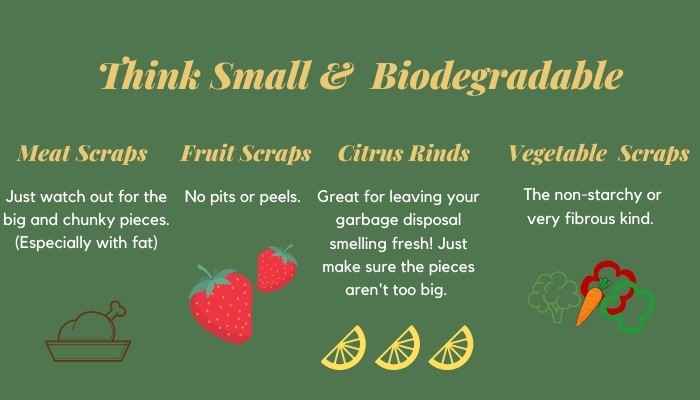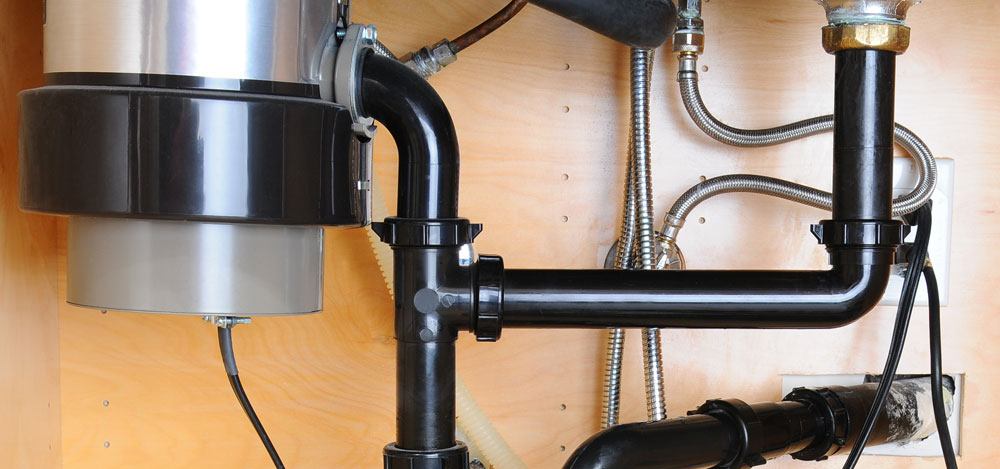With summer upon us and future barbecues and celebrations ahead, the last thing we want you to worry about is a plumbing problem like a clogged garbage disposal. Especially when you really need it to work! But if there is a clog, Simpson Plumbing is here to show you how to unclog a garbage disposal.
First off, one of the best ways to prevent garbage disposal clogs is to avoid putting foods in that aren’t meant for it. It’s important to remember that garbage disposals are not trash cans; you can’t throw everything in there (unfortunately). Otherwise, you will end up with a clog. That’s why you’re here now, right?
How to Unclog a Garbage Disposal
With a few simple steps, you should be able to get your garbage disposal unit up and grind those food scraps away. Here‘s how to unclog a garbage disposal:
- Safety First
- Is There Any Power?
- Take A Look
- Reset The Disposal
- Manual Operation
Safety First
If you find yourself with a clogged garbage disposal, don’t panic! The first step to tackling the problem is an important one – turn the power off. This keeps you safe while you work on the disposal. Luckily, it’s easy to do: the power switch is typically located in the cabinet below the sink, so you don’t have to search too far.
Once you’ve switched off the power, don’t forget to unplug the cord from the outlet. This way, you can be sure that there’s no chance of the disposal suddenly turning on while you’re working on it. With the power off and the cord unplugged, you’re ready to move on to the next step in unclogging your garbage disposal.
Is There Any Power?
If you find that your garbage disposal isn’t making any noise, there’s a chance that it may not be getting any power. You can easily remedy this issue by resetting the breaker. On the other hand, if the disposal is making a humming noise, then it’s likely that something has gotten jammed inside.
Don’t panic–that’s the good news! You may not need to replace the entire unit. But you will need to investigate the inside of the disposal to remove any foreign objects. By following these simple steps, you can avoid replacing the whole unit and keep your kitchen working smoothly.
Take A Look
Grab a flashlight and some pliers, and take a look at the garbage disposal opening. If it’s something obvious that’s stuck (like a fork), then removing that should fix the issue. Sometimes it’s caps, pieces of glass, little rocks, random debris, etc., which require extra caution.
For your safety, avoid putting your hands down the garbage disposal, even if it’s off. And if you are having trouble removing the object yourself, Simpson Plumbing is here to help. It’s a lot easier to replace a garbage disposal than a couple of fingers.
Reset The Disposal
Has your garbage disposal stopped working? Don’t worry – it may just need a quick reset! Look for a small button on the bottom or side of the disposal unit, which is usually red or black. This is the reset button.
Give it a firm press and hold it down for a few seconds. If it keeps popping out, you may need a new disposal, and that’s where Simpson Plumbing comes in! Don’t stress about fixing your garbage disposal – just give us a call and we’ll take care of it for you.
Manual Operation
If everything is in order to this point, you may need to manually grind the disposal yourself. It’s a relatively easy job, but you need to have an allen wrench or hex key and be able to get a good look at the bottom of the disposal. There should be a place for the wrench to go. A flashlight might be handy here, too.
Using the wrench, manually turn the disposal. You may need a lot of force, and that’s okay–the wrench will give way before you do any damage to the disposal itself. Once you’ve loosened it, rotate it in one direction a few times and then back the other way a few more times. Here’s a helpful video to get you started.
Once you’ve turned everything back on, run cold water or hot water, turn on the disposal, and see if it runs. If the water goes down the drain line freely and the disposal is in operation, you’re good to go. If the unit is working, but the water is still backing up, it’s probably an issue with the garbage disposal drain piping being clogged.
At this point, you have another issue on your hands and may need to call in the professionals. If the disposal still isn’t operational, you will probably need to have the unit looked at or replaced. Simpson Plumbing can help in either case.
How to Unclog a Garbage Disposal: Don’t Clog it in the First Place
When it comes to disposing of food waste and other items, a kitchen sink garbage disposal can be a great convenience. However, with the potential for frustrating blockages, it is important to be aware of what should never be put into a kitchen sink garbage disposal. The best way to handle clogs is to prevent clogs from ever happening.
To avoid damage to the unit itself or the plumbing connected to the unit, there are certain items that should not enter the disposal. These include bones, oil/grease, fibrous foods such as celery stalks, potato peels, and artichoke leaves, shells from shellfish such as lobster, clams, and mussels, popcorn kernels, and eggshells. Basically, if you wouldn’t bite into it, don’t put it in the garbage disposal.
These items are either too hard to break down inside of the machine or tend to cause clogs in pipes after being broken down by the blades. Grease and oil can also bind together solid particles (like small pieces of food) into larger clumps that are more likely to clog pipes downstream.
The oils are also highly corrosive on mechanical parts like blades, which can lead to premature deterioration of their function. And, of course, non-food items such as (and we can’t imagine you’d do this, but still..) bottle caps, plastic bags, paper towels and napkins, dental floss, twist ties, waxed paper, and other kitchen items.
As long as you keep these few basic rules in mind when using your garbage disposal, you should have no issues keeping your unit running properly for years to come!
What Can Be Put in a Kitchen Garbage Disposal?

It is important to understand what a kitchen sink garbage disposal is and how it operates before discussing the variety of items that can be put inside. A kitchen sink garbage disposal is an electrical appliance installed in the bottom of a kitchen sink drain.
It works by grinding up food scraps and other organic materials, which are then washed away through plumbing pipes. By grinding up food waste, a garbage disposal can help reduce the amount of trash that needs to be taken out each week, as well as reduce odors from decaying food in the trash.
In general, most organic food waste items such as soft fruit and vegetable scraps, small meat cuts and other similar items can all be placed into a garbage disposal with little problem. Softening agents like salt or baking soda should also be used whenever possible to help break down organic matter before it enters the drain.
This will help make sure that no clogs occur over time due to the build-up of food residue inside the piping. For those who find themselves with larger quantities of food waste to dispose of at once–such as when cooking for large parties–it may be best to opt for using composting methods to dispose of all food waste materials.
Composting is an environmentally friendly way to process organic materials back into nutrients for plants while reducing one’s carbon footprint at the same time! Composting bins come in a variety of sizes–some even fit on your kitchen counter–so you can use them if you’re in an apartment, condo, or large family home.
Still Unsure How to Unclog a Garbage Disposal? We Have Your Back
If at this point you lose interest or just want someone else to handle it, don’t worry, the experts at Simpson Plumbing are more than happy to help! Or maybe you’ve gone through all of the steps and it’s still not budging. That might mean you’re due for a new garbage disposal.
It’s not uncommon, especially if you’ve been living in your home for a while and never replaced it. But no matter what, there’s peace of mind when you know that a professional is taking care of the problem. (As well as a sense of relief when you don’t have to look at the grime in your garbage disposal and fish out the culprit, if any.)
In more than 40 years of being in business, Simpson Plumbing has seen it all, and we’re prepared! Let us know if you need your garbage disposal repaired or replaced, or if you’re having any other problems with your plumbing. We look forward to hearing from you!


 About Us
About Us  Services
Services  Plans
Plans  Commercial
Commercial